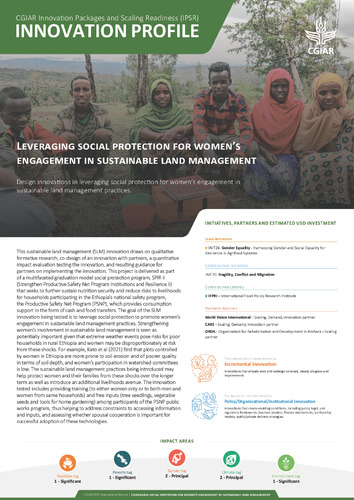Leveraging social protection for women’s engagement in sustainable land management: IPSR Innovation Profile. First edition, March 2024
Abstract
This sustainable land management (SLM) innovation draws on qualitative formative research, co-design of an innovation with partners, a quantitative impact evaluation testing the innovation, and resulting guidance for partners on implementing the innovation. This project is delivered as part of a multifaceted graduation model social protection program, SPIR II (Strengthen Productive Safety Net Program Institutions and Resilience II) that seeks to further sustain nutrition security and reduce risks to livelihoods for households participating in the Ethiopia’s national safety program, the Productive Safety Net Program (PSNP), which provides consumption support in the form of cash and food transfers. The goal of the SLM innovation being tested is to leverage social protection to promote women’s engagement in sustainable land management practices. Strengthening women’s involvement in sustainable land management is seen as potentially important given that extreme weather events pose risks for poor households in rural Ethiopia and women may be disproportionately at risk from these shocks. For example, Kato et al (2021) find that plots controlled by women in Ethiopia are more prone to soil erosion and of poorer quality in terms of soil depth, and women’s participation in watershed committees is low. The sustainable land management practices being introduced may help protect women and their families from these shocks over the longer term as well as introduce an additional livelihoods avenue. The innovation tested includes providing training (to either women only or to both men and women from same households) and free inputs (tree seedlings, vegetable seeds and tools for home gardening) among participants of the PSNP public works program, thus helping to address constraints to accessing information and inputs, and assessing whether spousal cooperation is important for successful adoption of these technologies.

